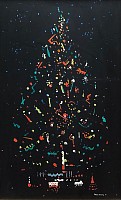BIOGRAPHY

Oscar Thalinger (American 1885-1965)
Oscar Thalinger's work evolved from realistic landscapes to non-objective abstract modernism. At age fifteen, Thalinger enrolled in the Art School in St. Louis, which later became the Fine Arts School of Washington University. There he studied painting and drawing during the day and sculpture at night.
Thalinger became known in the late 1920s and early thirties for his images of "old St. Louis landmarks and dwellings, which had lost their former glory". Along with other local artists of the twenties and thirties, "he sought both inspiration and escape from the city's problems. During this period he did Regionalist subjects and participated in the Ste. Genevieve Art Colony, a group of painters attracted to the picturesque town of St. Genevieve, Missouri near St. Louis.
While expanding his subject matter his style remained the same; however he was intrigued by distortion of perspective and abandonment of realism. French-inspired Cubism and German-inspired Abstract Expressionism may have challenged him while studying in both Paris and Munich during the first decade of the twentieth century.
With this influence his work went from the social realism of the twenties and thirties, which was then dominant, to American modernism after the war. Modernism would remain his style and in 1946 the City Art Museum of St. Louis acquired his work for its permanent collection.
Grouping his work into three categories, Thalinger's retrospective exhibit was presented to St. Louis in 1955. The majority of his paintings displayed were abstract and non-objective with three examples of "representational-subjective" (realist).
Thalinger was a member of the Artists' Guild, the St. Louis Art League, the 2 x 4 Society and was President of Artists Equity.
